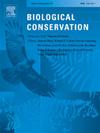雪豹、猎物和牲畜之间的时空相互作用——对共存的影响
IF 4.9
1区 环境科学与生态学
Q1 BIODIVERSITY CONSERVATION
引用次数: 0
摘要
放牧是世界上最激烈的人类活动之一,即使在保护区内也是如此。了解野生动物和牲畜的生存特征是物种保护的基础。需要对野生动物与牲畜的相互作用进行长期研究,以更好地探索野生动物与牲畜冲突的根源,并提供有效的保护建议。2015 - 2022年,在四川卧龙自然保护区雪豹栖息地设置红外相机陷阱,从空间分布、日常活动模式和栖息地利用模式三个方面分析雪豹、蓝羊和家牦牛之间的相互作用。空间重叠度较高,平均为65.4%。雪豹是黄昏活动,而蓝羊和家牦牛是白天活动。家牦牛的整体适应能力低于蓝羊,活动模式随时间的变化比野生物种更明显,在选择低海拔和平缓坡度的地区时,栖息地利用模式的差异更大。日常活动模式、栖息地利用和占用概率随时间的变化是周期性的,表明物种间生态位随时间的复杂变化。为了缓解未来的畜禽冲突,我们建议1)控制畜禽数量,2)提高环境承载能力,3)优化政策以允许畜禽和野生动物之间的生态位分化。本研究有助于指导未来的研究方向和制定有效的全球畜牧管理政策。本文章由计算机程序翻译,如有差异,请以英文原文为准。
Spatio-temporal interactions between snow leopards, prey, and livestock- implications for coexistence
Livestock grazing is one of the most intense human activities worldwide, even within protected areas. Understanding the survival characteristics of wildlife and livestock is fundamental to species conservation. Long-term studies of wildlife-livestock interactions are needed to better explore the roots of wildlife-livestock conflict and provide effective protection suggestions. Here, we deployed infrared camera traps in snow leopard habitat in Wolong Nature Reserve, Sichuan, China from 2015 to 2022 and analyzed the interactions among snow leopards, blue sheep, and domestic yaks over time with respect to three aspects: spatial distribution, daily activity patterns, and habitat use patterns. We found a high spatial overlap among all three species (average 65.4 %). Snow leopards were crepuscular, while blue sheep and domestic yaks were diurnal. Domestic yaks showed evidence of an overall lower adaptive capacity than blue sheep, with more pronounced shifts in activity patterns over time than the wild species, as well as a more divergent habitat use pattern in choosing areas at lower elevation and with gentler slopes. Changes in daily activity patterns, habitat use and occupancy probability over time were cyclical and suggest complex shifts in niche over time among species. To mitigate wildlife-livestock conflicts in the future, we recommend 1) controlling the number of livestock, 2) improving the carrying capacity of the environment, and 3) optimizing policies to allow for niche differentiation between livestock and wildlife. Our study is helpful for guiding future research directions and formulating effective livestock management policies worldwide.
求助全文
通过发布文献求助,成功后即可免费获取论文全文。
去求助
来源期刊

Biological Conservation
环境科学-环境科学
CiteScore
10.20
自引率
3.40%
发文量
295
审稿时长
61 days
期刊介绍:
Biological Conservation is an international leading journal in the discipline of conservation biology. The journal publishes articles spanning a diverse range of fields that contribute to the biological, sociological, and economic dimensions of conservation and natural resource management. The primary aim of Biological Conservation is the publication of high-quality papers that advance the science and practice of conservation, or which demonstrate the application of conservation principles for natural resource management and policy. Therefore it will be of interest to a broad international readership.
 求助内容:
求助内容: 应助结果提醒方式:
应助结果提醒方式:


